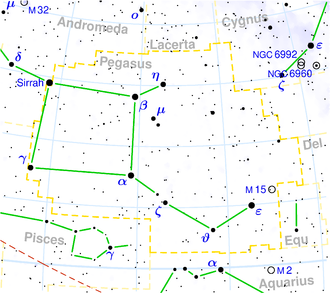IC 5160
| Galaxie IC 5160 | |
|---|---|
 | |
| SDSS-Aufnahme | |
| AladinLite | |
| Sternbild | Pegasus |
| Position Äquinoktium: J2000.0, Epoche: J2000.0 | |
| Rektaszension | 22h 03m 04,8s[1] |
| Deklination | +10° 55′ 29″[1] |
| Erscheinungsbild | |
| Morphologischer Typ | SB0[2] |
| Helligkeit (visuell) | 14,4 mag[2] |
| Helligkeit (B-Band) | 15,4 mag[2] |
| Winkelausdehnung | 1,10' × 0,8'[2] |
| Positionswinkel | 22°[2] |
| Flächenhelligkeit | 14,1 mag/arcmin²[2] |
| Physikalische Daten | |
| Rotverschiebung | 0.029487[1] |
| Radialgeschwindigkeit | 8840 km/s[1] |
| Hubbledistanz vrad / H0 | (403 ± 28) · 106 Lj (123,6 ± 8,6) Mpc [1] |
| Geschichte | |
| Entdeckung | Stéphane Javelle |
| Entdeckungsdatum | 15. Oktober 1903 |
| Katalogbezeichnungen | |
| IC 5160 • UGC 11884 • PGC 67929 • CGCG 428-018 • 2MASX J22030481+1055296 • 2MASS J22030482+1055293 • LDCE 1500 NED002 | |
IC 5160 ist eine Linsenförmige Galaxie vom Hubble-Typ SB0 im Sternbild Pegasus am Nordsternhimmel. Sie ist schätzungsweise 403 Millionen Lichtjahre von der Milchstraße entfernt und hat einen Durchmesser von etwa 130.000 Lichtjahren.
Im selben Himmelsareal befindet sich u. a. die Galaxie NGC 7190.
Das Objekt wurde am 15. Oktober 1903 von Stéphane Javelle entdeckt.[3]
Siehe auch
Weblinks
Einzelnachweise
Auf dieser Seite verwendete Medien
Autor/Urheber: Sloan Digital Sky Survey, Lizenz: CC BY 4.0
The sky image is obtained by Sloan Digital Sky Survey, DR14 with SciServer.
Angle of view: 4' × 4' (0.3" per pixel), north is up.
Details on the image processing pipeline: https://www.sdss.org/dr14/imaging/jpg-images-on-skyserver/



